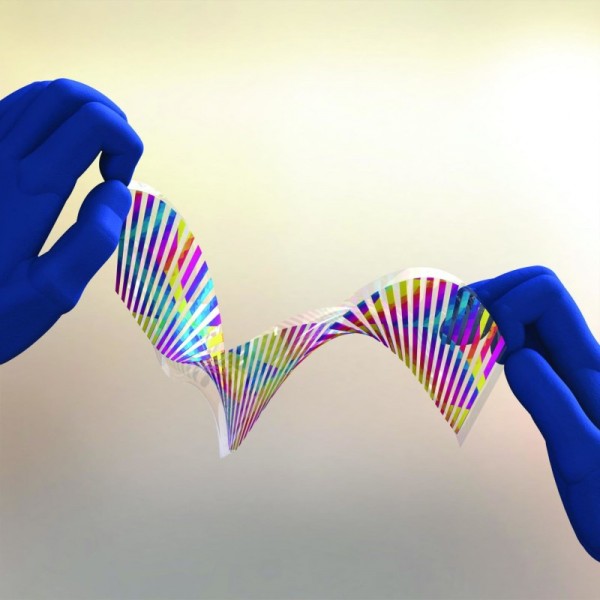Engineers Develop Chameleon-Like Skin that Changes Color on Demand
| Marco Foronda | | Mar 13, 2015 01:07 PM EDT |
(Photo : The Optical Society (OSA)) Developed by engineers from the University of California at Berkeley, this chameleon-like artificial "skin" changes color as a minute amount of force is applied.
University of California at Berkeley engineers have developed an artificial skin that can change its color on demand, the way a chameleon does, said a paper published by The Optical Society on Friday.
A material that camouflages by bending light is an innovation no one has done before, said Professor Connie Chang-Hasnain of the Berkeley team.
Like Us on Facebook
Researchers accurately ingrained rows of micro ridges onto a super thin silicon film about 120 nanometers thick or a thousand times thinner than a hair strand. This film is set on flexible silicone.
The team chose specific colors the film will reflect according to the way it's bent or flexed.
To make it reflect specific colors, you have to tune the spaces between the tiny ridges. By bending or flexing it, you slightly alter these spaces and thus, the color.
"If you have a surface with very precise structures, spaced so they can interact with a specific wavelength of light, you can change its properties and how it interacts with light by changing its dimensions," said Chang-Hasnain.
The method they used controlled the features of a surface to make it reflect specific wavelengths of light instead of the entire rainbow. Some insects like butterflies use this less common process to display iridescent colors, according to the paper.
This process is in contrast to controlling a material's chemical composition, such as with pigments and dyes. For instance, a leaf during autumn changes color because its chemical composition changes. Such processes are more common in nature.
The chameleon-like skin innovation can reflect pure colors and up to 83 percent of light. Moreover, it's easy to produce with a wide range of properties, she said.
The paper also highlights practical uses of the innovation, particularly in the category of color display technologies. It can also act as a sensor to indicate defects in aircraft and public infrastructure.
TagsThe Optical Society, University of California, Berkeley, Chameleon, Connie Chang-Hasnain
©2015 Chinatopix All rights reserved. Do not reproduce without permission
EDITOR'S PICKS
-

Did the Trump administration just announce plans for a trade war with ‘hostile’ China and Russia?
-

US Senate passes Taiwan travel bill slammed by China
-

As Yan Sihong’s family grieves, here are other Chinese students who went missing abroad. Some have never been found
-

Beijing blasts Western critics who ‘smear China’ with the term sharp power
-

China Envoy Seeks to Defuse Tensions With U.S. as a Trade War Brews
-

Singapore's Deputy PM Provides Bitcoin Vote of Confidence Amid China's Blanket Bans
-

China warns investors over risks in overseas virtual currency trading
-

Chinese government most trustworthy: survey
-

Kashima Antlers On Course For Back-To-Back Titles
MOST POPULAR
LATEST NEWS
Zhou Yongkang: China's Former Security Chief Sentenced to Life in Prison

China's former Chief of the Ministry of Public Security, Zhou Yongkang, has been given a life sentence after he was found guilty of abusing his office, bribery and deliberately ... Full Article
TRENDING STORY

China Pork Prices Expected to Stabilize As The Supplies Recover

Elephone P9000 Smartphone is now on Sale on Amazon India

There's a Big Chance Cliffhangers Won't Still Be Resolved When Grey's Anatomy Season 13 Returns

Supreme Court Ruled on Samsung vs Apple Dispute for Patent Infringement

Microsoft Surface Pro 5 Rumors and Release Date: What is the Latest?










